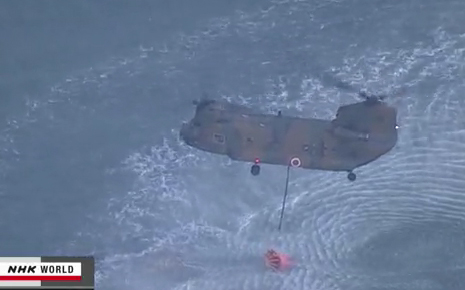Radiation levels at plant falling; unclear whether cooling working.
Separate desperate battles raged Friday to cool down a spent fuel pool and three reactors at the Fukushima No. 1 nuclear plant to keep highly toxic radiation from being released into the environment.
Operator Tokyo Electric Power Co. was also trying to set up new power lines from the outside and connect them to various facilities in the troubled plant in an effort to reactivate cooling pumps and emergency core cooling systems of the troubled reactors.
If the devices are unbroken and can get electricity, they could be a significant help in Tepco's efforts to stabilize the crippled plant. Tepco was aiming to finish connecting the power lines to the No. 1 and 2 reactor units by the end of Friday, and to the No. 3 and No. 4 units Sunday.
"We will concentrate on the work to set up the electricity lines from the outside," Chief Cabinet Secretary Yukio Edano said.
Meanwhile, data released by Tepco indicated the radiation level at one sampling point at the west gate to the nuclear plant had steadily decreased to 265.0 microsieverts at 11 a.m. Friday from 351.4 microsieverts as of 12:30 a.m. Thursday. The west gate, located within the plant's compound, is 1.1 km west of the No. 2 reactor unit.
This could be a sign of a steady decline trend in radiation released from the plant, but it is still unclear if it was because of the use of water to cool down the spent fuel.
The unprecedented cooling mission, launched Thursday by the Self-Defense Forces by spraying tons of water at the plant's No. 3 reactor building, was bolstered Friday.
SDF firetrucks shot 50 tons of water at the spent fuel pool within the No. 3 reactor building in the afternoon, along with a high-pressure water cannon truck on loan from the U.S. military, after aiming up to 60 tons of water at it and dumping water from two helicopters the day before.
"Because steam is rising, there is no doubt the water reached the storing pool," Edano, the government's top spokesman, said of Thursday's operation. "But we still don't have information on how much water" got to the target.
The spent fuel pools in the power station lost their cooling function in the wake of the March 11 killer quake and tsunami. It is also no longer possible to monitor the water levels or temperatures in any of the pools for the four reactors.
Amid the nuclear crisis, Edano said the government may shift policy from depending on nuclear power for energy following a similar remark by Liberal Democratic Party President Sadakazu Tanigaki the day before.
"The government is not yet in a place where we've made a decision but (Tanigaki's remark) is reasonable," Edano said.
On Thursday, Tanigaki told a news conference it will be increasingly difficult for the government to build new nuclear plants in the future.
"The situation became difficult to promote nuclear energy," he said.
Japan depends on nuclear power plants for about 29 percent of its energy, compared with thermal power plants, including natural gas, gasoline and coal, providing 61 percent.
Information added from Kyodo
©japantimes.co.jp





No comments:
Post a Comment
Note: Only a member of this blog may post a comment.